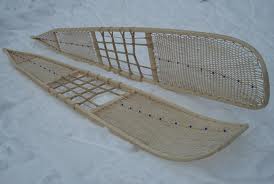Athapaskan
The ancestors of Athapaskan speakers dispersed throughout the Sub-Arctic region, with groups splitting away and moving onto the Plains and Plateau regions. The languages of the Athapaskan language group are Chipewyan, Beaver, Dene, Dene Dhaa, Tsuu T'ina (Sarcee), Sekani, Kaska, Tutchone, Han, and Gwich'n. All of these languages have several similar traits, which supports the theory that the ancestors of these speakers migrated relatively recently, and as a group.
The Athapaskan bands were groups of extended families that co-operated in resource procurement. The bands enhanced their numbers by maintaining social networks with neighbouring bands. These alliances were often created from marriage ties. Polygamy was practised by the elder men of the band and this forced the younger men to wait until they earned the right to marry. Girls married soon after puberty, while young men were adults before they married. This trend created a large number of widows. Names were given to children based upon behaviours or signs that were thought to reveal a child's character. An Athapaskan belief was that a baby born with one to two teeth was reincarnated from a previous life. Children of the Dene Dhaa were given their father's name at birth. The father was then known as 'father of'.
The Dene had a well-defined set of rules that were governed by a group of elders. They monitored three aspects of band life. Natural resources were the first priority, family issues were the second, and the third was local government. Individuals who broke the rules were disciplined by reprimand from the elders. A more serious infraction was disciplined with public censure.
Athapaskan speakers occupied the forest and tundra territories of the sub-arctic. They lived within the rhythms of their environment and as a result did not leave debris, which often occurs around human settlement. Archaeologists, therefore, have difficulty reconstructing a model of Athapaskan life because very little trace of their existence was left upon the environment. Ornamented bone tools incised with linear engravings, as well as scrapers and pendants are the artefacts that constitute the archaeological record of the Athapaskans.
 Hunting and gathering were major activities for Athpaskans, and spirituality was linked to the finding of food and survival in a harsh climate. Supernatural spirits were thanked if resources were plentiful. If resources were scarce then the spirits were appeased with offerings. One of the supernatural beings, or bogeymen, feared was Kakhani. He was identified as a half-man, half-monster, and feared as an evil spirit who stole children. Athapaskans decorated their snowshoes with paint, strings of shells, and, frequently among the western tribes, with amulets woven into the snowshoe's babiche to keep the wearer safe from unfriendly spirits.
Hunting and gathering were major activities for Athpaskans, and spirituality was linked to the finding of food and survival in a harsh climate. Supernatural spirits were thanked if resources were plentiful. If resources were scarce then the spirits were appeased with offerings. One of the supernatural beings, or bogeymen, feared was Kakhani. He was identified as a half-man, half-monster, and feared as an evil spirit who stole children. Athapaskans decorated their snowshoes with paint, strings of shells, and, frequently among the western tribes, with amulets woven into the snowshoe's babiche to keep the wearer safe from unfriendly spirits.
The Athapaskans also believed that the crow and owl spoke to humans. Ivory spirit-helpers, in the shape of animals, were the tools used by shamans to perform rituals. Holy men or women were primarily healers but they also foretold the weather and location of game. The shaman also presided over rituals for the dead. The deceased was believed to travel to a western land where all of the deceased relatives lived. The shaman and mourners would light fires for four nights to aid the soul on its journey.